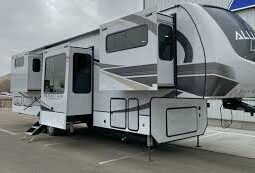Regardless of how often you travel in your RV, a supply of fresh water is crucial—especially if you plan on using the faucets in the kitchen or the shower in the bathroom. When you’re boondocking or dry camping, that supply will eventually get low, and you’ll need to refill the tank with fresh water at some point.
Although some campgrounds may include a water fill station, many off-the-grid boondocking don’t have any amenities at all. This can make figuring out where to fill RV fresh water tank much more difficult. However, it doesn’t need to be a chore—there are more places to fill up while you’re boondocking than you might think.
The Best Places to Fill Up
Depending on where you’re parked, the first place to check for a water fill station is the campground or area that you’re staying in. If the location doesn’t have one, there may still be a nearby RV or public dump site that also allows you to fill your tank up.
Even if you are boondocking in the middle of nowhere, there is still a significant chance that a dump site is located within driving distance. Keep in mind that while some dump stations may be free, others may charge a small fee to use their water.
Before filling up, it’s also important to make sure the water source is “potable” since potable water is typically safe to drink.
Travel centers are also another convenient place to refill at if you’re camping near a major highway or interstate. Although more accessible than a dump site, you will likely need to pay if you plan on refilling.
However, even if you have traveled far enough away from dump sites and travel centers, you still may be able to access fresh water at a national forest. Many national forests house campgrounds for RVs and camping trailers to park in, which means they also tend to have communal water fill stations as well. Depending on the specific campground, there may be restrictions on whether or not non-campers can use it.
How to Refill Your Fresh Water Tank
Knowing where to fill RV fresh water tank is only part of the process—knowing how to fill it up when you find a water source is just as important. Although there are several techniques out there, this one may save you time and money. Before you begin, there are a few key items you’ll need:
● Water can with a spout (which usually runs anywhere from $15 to $25)
● Water bandit (typically around $5 to $10)
● RV water tank attachment (which you can purchase online or through RV manufacturers
● RV water hose (generally priced around $10 to $30 depending on the length)
In some cases, you may also need to purchase a portable electric pump if your RV doesn’t come with a gravity fed water filling point.
Once you’ve got your supplies, the first thing to do is drill a small hole in the empty water can above the fill line. Before you fill up the can, place a cap or screw in the hole so that water doesn’t leak out of it.
Next, you should place the jug above the filling point, and connect your water bandit, tank attachment, and hose together. The end of the hose that contains the water bandit should attach to the water can’s spout.
After placing the water filling attachment into the RV’s filling hole, the last step is to remove the screw or cap you placed on the can, and let the water flow. If it doesn’t begin to flow immediately, you might have to lift up the hose but should be able to let it go once the water begins to drain from the can.
Depending on the size of your tank, you may need to repeat this technique a few times before your RV’s fresh water supply is completely refilled.
Other Tips to Keep in Mind With a Fresh Water Tank
Knowing how and where to refill your fresh water tank is essential when you’re off the grid, but it’s not the only thing an amateur or expert RV traveler should be aware of.
Campers who have never been boondocking for any significant amount of time may not realize they need to sanitize their water tank every six months (or sooner if they suspect there’s an issue).
It’s also important to know your RV’s limitations. A brand new RV is likely to be more self-sufficient on the road while an older one might be less convenient on longer trips. Before heading out for several months, a short boondocking or dry camping trip might help you realize what your RV’s specific limitations are—such as how often you need to refill the water tank, what equipment you require, and how much battery power you use on a daily basis.
Speaking of water, knowing how to conserve it can make all the difference when you’re camping without a hook-up. The more water you conserve, the less often you’ll need to refill the supply or leave the location where you’re parked. Bad habits like letting the faucet run when you aren’t using it or taking a long shower can end up costing you a lot of water in the long run.
Purchasing the supplies you’ll need to refill your water tank before going on your trip is also crucial. Even if you don’t plan on refilling the tank, having the supplies on hand is still a good idea.
Boondocking can be an enjoyable hobby for both amateur and expert RV owners alike, but a fun adventure can quickly become a miserable one if you don’t know where to find a water source. If there isn’t one located in your campground or camping spot already, there’s a good chance that a public dumping site, traveling center or national forest is nearby—and has all the fresh water you need to refill your tank.
